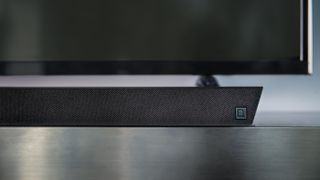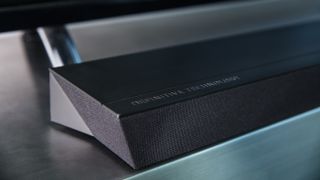This Chromecast-enabled soundbar transmits room-shaking sound for serious cinephiles
It'll cost you, though

Slim, sleek, and subwoofer-ready; the new Definitive Technology Studio Slim promises to be the soundbar of any dedicated cinephile's dreams.
Announced at IFA 2019, the new soundbar is Chromecast-enabled too, meaning it's just as much a part of the smart home as it is a part of your home cinema setup.
- The best soundbars you can buy in 2019
- The best cheap soundbar deals and sales this month
- Check out our favorite soundbar: the Samsung HW-Q90R
What does that mean in real terms? Having Chromecast built-in also has the benefit of allowing you to easily cast your music, favorite radio stations, and podcasts from your smartphone to the soundbar over Wi-Fi.
Unlike a Bluetooth connection, this enables you to connect multiple devices to the soundbar simultaneously and control your music playback wherever you are in your home.
This also means that you can hook this soundbar up to your other Chromecast-enabled speakers via the Google Home app to create an entire home audio system.
So, if you have a Google Home speaker like the Google Home Max or Google Home Hub, you can give voice commands to the Google Assistant built into these speakers to control playback on the Studio Slim soundbar.

Room-filling sound
Now, let's get down to the audio nitty-gritty: the Studio Slim soundbar features left, center, and right channels, which are driven by seven individual transducers and amplifiers.
Get daily insight, inspiration and deals in your inbox
Get the hottest deals available in your inbox plus news, reviews, opinion, analysis and more from the TechRadar team.
Definitive Technology says that this delivers "room-filling three channel sound, for precise imaging, wide soundstage, and reproduction of surround content", while the adjustable center channel "allows users to custom tailor" the voicing of the soundbar.
Three one-inch aluminum dome tweeters and with four three-inch oval drivers work in tandem with the accompanying eight-inch subwoofer, which should a welcome boost of bass to your favorite film's soundtrack.
The soundbar comes with three EQ presets (Movies, Music, and Night), which should make it easier to switch between different types of content.
According to Definitive Technology, Movie mode "widens the sound stage and heightens dialogue and effects for immersive home theater", while Music mode "focuses the imaging and simplifies processing, resulting in accurate, uncolored reproduction" – this should appeal to purist audiophiles.
Meanwhile, Night mode "tailors overall output and bass response for more subdued late-night viewing", so your explosion-laden action film shouldn't disturb your long-suffering neighbors.

Cinematic audio comes at a cost
In terms of connectivity, the soundbar hooks up to your TV via a single HDMI cable, and as it's HDMI ARC-enabled, you can control it using your TV's existing remote control.
The use of one cable also means you don't have to deal with annoying wires cluttering the space behind your TV – and saving space is exactly what Definitive Technology had in mind when it designed the Studio Slim soundbar.
Standing at just under two inches tall, the soundbar shouldn't block the bottom edge of your TV, and it's brushed aluminum top panel should look great in any home.
If all that sounds good, you may be a little perturbed by the price; at $999 / £999 (around AU$1800), it's one of the pricier soundbars we've come across – still, it's not the most expensive we've seen, and if it lives up to its impressive spec list, it could prove to be well worth the money.
- IFA 2019 is Europe's biggest tech show. The TechRadar team is in Berlin to bring you all the breaking news and hands-on first impressions of new TV, watches and other tech as they're announced.
Olivia was previously TechRadar's Senior Editor - Home Entertainment, covering everything from headphones to TVs. Based in London, she's a popular music graduate who worked in the music industry before finding her calling in journalism. She's previously been interviewed on BBC Radio 5 Live on the subject of multi-room audio, chaired panel discussions on diversity in music festival lineups, and her bylines include T3, Stereoboard, What to Watch, Top Ten Reviews, Creative Bloq, and Croco Magazine. Olivia now has a career in PR.

